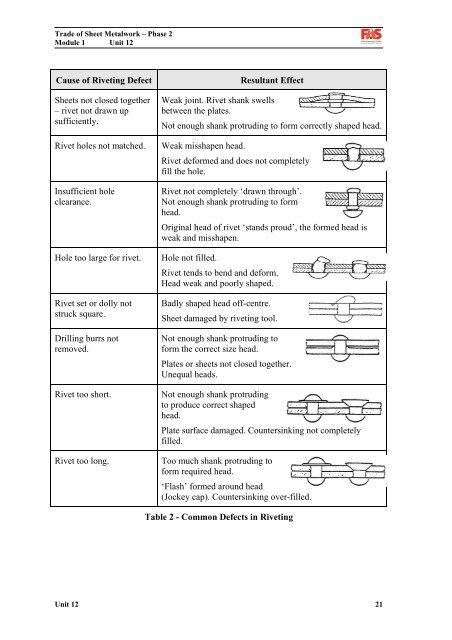Create successful ePaper yourself
Turn your PDF publications into a flip-book with our unique Google optimized e-Paper software.
Trade of Sheet Metalwork – Phase 2<br />
Module 1 Unit 12<br />
Cause of <strong>Riveting</strong> Defect Resultant Effect<br />
Sheets not closed together<br />
– rivet not drawn up<br />
sufficiently.<br />
Weak joint. Rivet shank swells<br />
between the plates.<br />
Rivet holes not matched. Weak misshapen head.<br />
Insufficient hole<br />
clearance.<br />
Hole too large for rivet. Hole not filled.<br />
Rivet set or dolly not<br />
struck square.<br />
Drilling burrs not<br />
removed.<br />
Not enough shank protruding to form correctly shaped head.<br />
Rivet deformed and does not completely<br />
fill the hole.<br />
Rivet not completely ‘drawn through’.<br />
Not enough shank protruding to form<br />
head.<br />
Original head of rivet ‘stands proud’, the formed head is<br />
weak and misshapen.<br />
Rivet tends to bend and deform.<br />
Head weak and poorly shaped.<br />
Badly shaped head off-centre.<br />
Sheet damaged by riveting tool.<br />
Not enough shank protruding to<br />
form the correct size head.<br />
Plates or sheets not closed together.<br />
Unequal heads.<br />
Rivet too short. Not enough shank protruding<br />
to produce correct shaped<br />
head.<br />
Plate surface damaged. Countersinking not completely<br />
filled.<br />
Rivet too long. Too much shank protruding to<br />
form required head.<br />
‘Flash’ formed around head<br />
(Jockey cap). Countersinking over-filled.<br />
Table 2 - Common Defects in <strong>Riveting</strong><br />
Unit 12 21
















